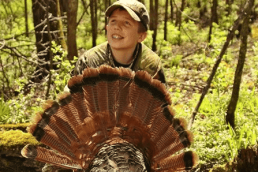Spaulding Outdoors
SHARE THIS POST
Busy time for the birdfeeder
A lot of people miss out on some excellent bird watching by not keeping their feeders filled. Just because there are leaves on the trees doesn’t mean our feathered friends no longer need a supply of protein. Actually, with the rigors of mating and nest building, birds are in need of an easily obtained, high-protein diet.
Lately, the feeder attendee list has looked like a “Who’s Who” of the bird world. My neighbors, Jack and Linda, and I have both entertained some beautiful rose-breasted grosbeaks. Jack and Linda briefly had a stunning Baltimore oriole drop by for a quick visit. I also had a visit from a white-crowned sparrow and a gorgeous Eastern towhee was seen picking through the crumbs for an easy meal.
Over the past few years, the downy woodpeckers have grown more tolerant of me. Whenever I refill the suet holder and back up a couple steps, they swoop in and start nibbling away. A few days ago I had one almost land on my head as I put the suet cake in the feeder.
Indiana’s 2016 white-tailed deer report
The “2016 Indiana White-tailed Deer Summary,” a comprehensive report on deer management in the state, is now available on the DNR website. The report contains information on deer hunting, use of depredation permits, deer-vehicle collisions and disease surveillance efforts.
In 2016, hunters harvested 119,477 white-tailed deer in Indiana. This is a 4 percent decrease from the 2015 harvest of 124,769 deer. Harvest information by equipment type and sex is available in the report. Also, harvest numbers, antlerless quotas and hunter attitude information is included for each of Indiana’s 92 counties.
Harvest numbers exceeded 1,000 deer in 58 counties and 2,000 deer in 14 counties. The 10 counties with the highest harvests were Harrison, Noble, Franklin, Washington, Steuben, Parke, Dearborn, Lawrence, Switzerland and Greene.
The state issued 311 deer depredation permits in 2016 with an average of 13 deer authorized per permit, and with an average of five deer taken per permit. The number of deer taken with depredation permits represents around 1.3 percent of the total deer taken in Indiana with 1,556 deer harvested.
Deer-vehicle collisions across Indiana were down nearly 9 percent from 2015 with 14,021 collisions in 2016. Disease surveillance for deer included monitoring for epizootic hemorrhagic disease (EHD), chronic wasting disease (CWD) and bovine tuberculosis (bTB). Bovine tuberculosis monitoring and surveillance was conducted in Dearborn, Fayette and Franklin counties near an outbreak on a cattle farm.
In other data, there was a crop damage report of just more than 25 percent.
The entire report is at deer.dnr.IN.gov in the “Deer Management” link and then “2016 Indiana White-tailed Deer Summary.”
Child airlifted after ATV crash
A lot of young people get hurt on ATVs. Usually it’s a situation or combination of driving too fast or dangerously, a lack of safety equipment or, in this case, a driver is too young.
Are you enjoying this post?
You can be among the first to get the latest info on where to go, what to use and how to use it!
Indiana conservation officers are investigating an all-terrain vehicle (ATV) crash injuring a 3-year-old child. On the evening of April 30, Hudson Otter, 3, was operating a TAOTAO Boulder B1 110cc ATV on private property near Seymour Road in Switzerland County. The ATV rolled and pinned Otter underneath. The child’s father, who was supervising his ATV operation at the time of the crash, quickly removed the ATV from him and called 911.
Otter was wearing a helmet at the time of the crash, which is believed to have significantly reduced further injury.
He was airlifted to a children’s hospital for an apparent broken arm, but the extent of his injuries are unknown at this time and do not appear to be life threatening.
Officials are currently investigating the accident.
Indiana conservation officers strongly encourage riders to wear a helmet and necessary safety equipment no matter the age or experience of the rider, and should do so at all times. Appropriately sized helmets, safety gear and ATV size should be considered for each individual rider and can greatly reduce the severity of injury in the event of a crash.
Firewood rule for campers on DNR properties
With camping season here, visitors to DNR properties should brush up on the DNR firewood rule. The rule helps protect Indiana’s trees from unknown pests and the 140 known insects and pathogens currently affecting the forests. Several of these are transported through firewood movement.
Under the rule, visitors to state parks, reservoirs, state forests and state fish and wildlife areas may bring firewood from home as long as the bark has been removed. Removing the bark minimizes the risk of accidental infestation through firewood movement because insect larvae live in sapwood under the bark.
Guests may also bring firewood into DNR properties kiln-dried scrap lumber, firewood purchased outside the property that bears either a USDA compliance stamp or a state compliance stamp and wood purchased from the property camp store or on-site firewood vendor and has a state compliance stamp.
Regardless of where visitors get their firewood, they should burn it all at the campsite safely before they leave.
In short, the firewood rule essentially means, “buy it with a stamp, bring it debarked, burn it all.” For more about the rule see firewood.dnr.IN.gov.
MWO
SHARE THIS POST
Did you enjoy this post?
You can be among the first to get the latest info on where to go, what to use and how to use it!
Jack Spaulding
Jack Spaulding is an outdoor columnist living in his hometown of Moscow, Ind. with his wife, Chris. From childhood, the smallmouth bass-infested Big Flat Rock River and the surrounding hardwood forest has been his playground. He has written Spaulding Outdoors for MidWest Outdoors since 1986. Email to jackspaulding@hughes.net.



